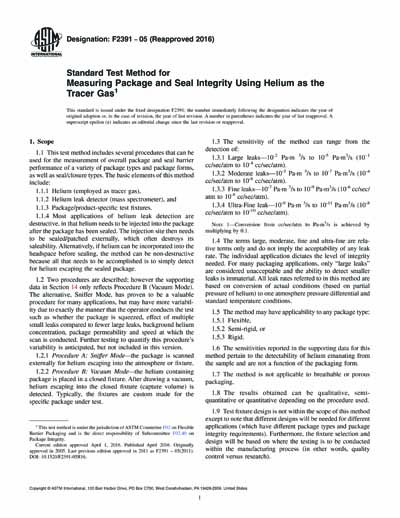Historical
ASTM F2391-05(2016)
Standard Test Method for Measuring Package and Seal Integrity Using Helium as the Tracer Gas
1.1 This test method includes several procedures that can be used for the measurement of overall package and seal barrier performance of a variety of package types and package forms, as well as seal/closure types. The basic elements of this method include:...
1.2 Two procedures are described; however the supporting data in Section 14 only reflects Procedure B (Vacuum Mode). The alternative, Sniffer Mode, has proven to be a valuable procedure for many applications, but may have more variability due to exactly the manner that the operator conducts the test such as whether the package is squeezed, effect of multiple small leaks compared to fewer large leaks, background helium concentration, package permeability and speed at which the scan is conducted. Further testing to quantify this procedure’s variability is anticipated, but not included in this version.
1.3 The sensitivity of the method can range from the detection of:...
1.4 The terms large, moderate, fine and ultra-fine are relative terms only and do not imply the acceptability of any leak rate. The individual application dictates the level of integrity needed. For many packaging applications, only “large leaks” are considered unacceptable and the ability to detect smaller leaks is immaterial. All leak rates referred to in this method are based on conversion of actual conditions (based on partial pressure of helium) to one atmosphere pressure differential and standard temperature conditions.
1.5 The method may have applicability to any package type:...
1.6 The sensitivities reported in the supporting data for this method pertain to the detectability of helium emanating from the sample and are not a function of the packaging form.
1.7 The method is not applicable to breathable or porous packaging.
1.8 The results obtained can be qualitative, semi-quantitative or quantitative depending on the procedure used.
1.9 Test fixture design is not within the scope of this method except to note that different designs will be needed for different applications (which have different package types and package integrity requirements). Furthermore, the fixture selection and design will be based on where the testing is to be conducted within the manufacturing process (in other words, quality control versus research).
1.10 This standard does not purport to address all of the safety concerns, if any, associated with its use. It is the responsibility of the user of this standard to establish appropriate safety and health practices and determine the applicability of regulatory limitations prior to use.
ASTM International [astm]

